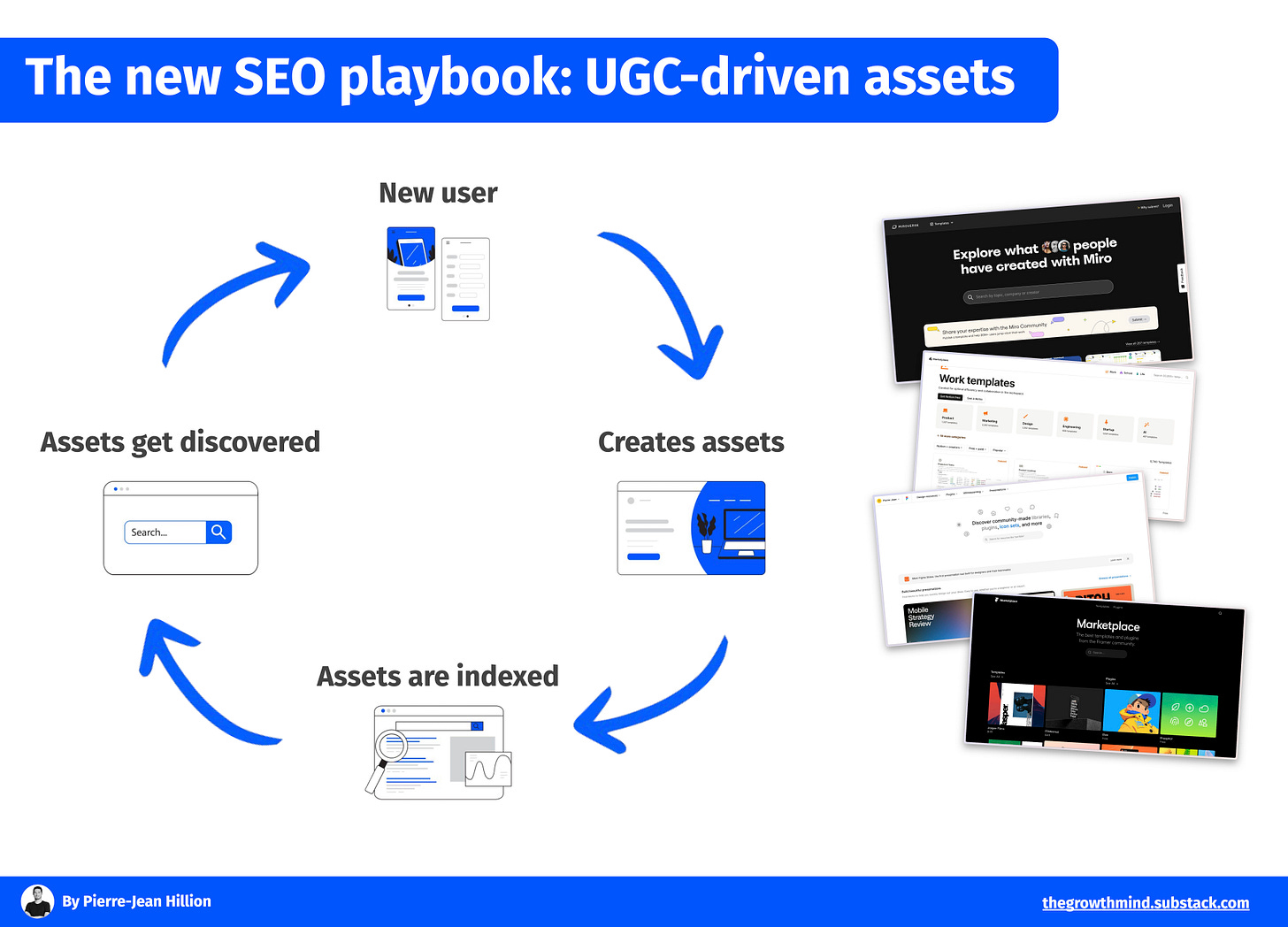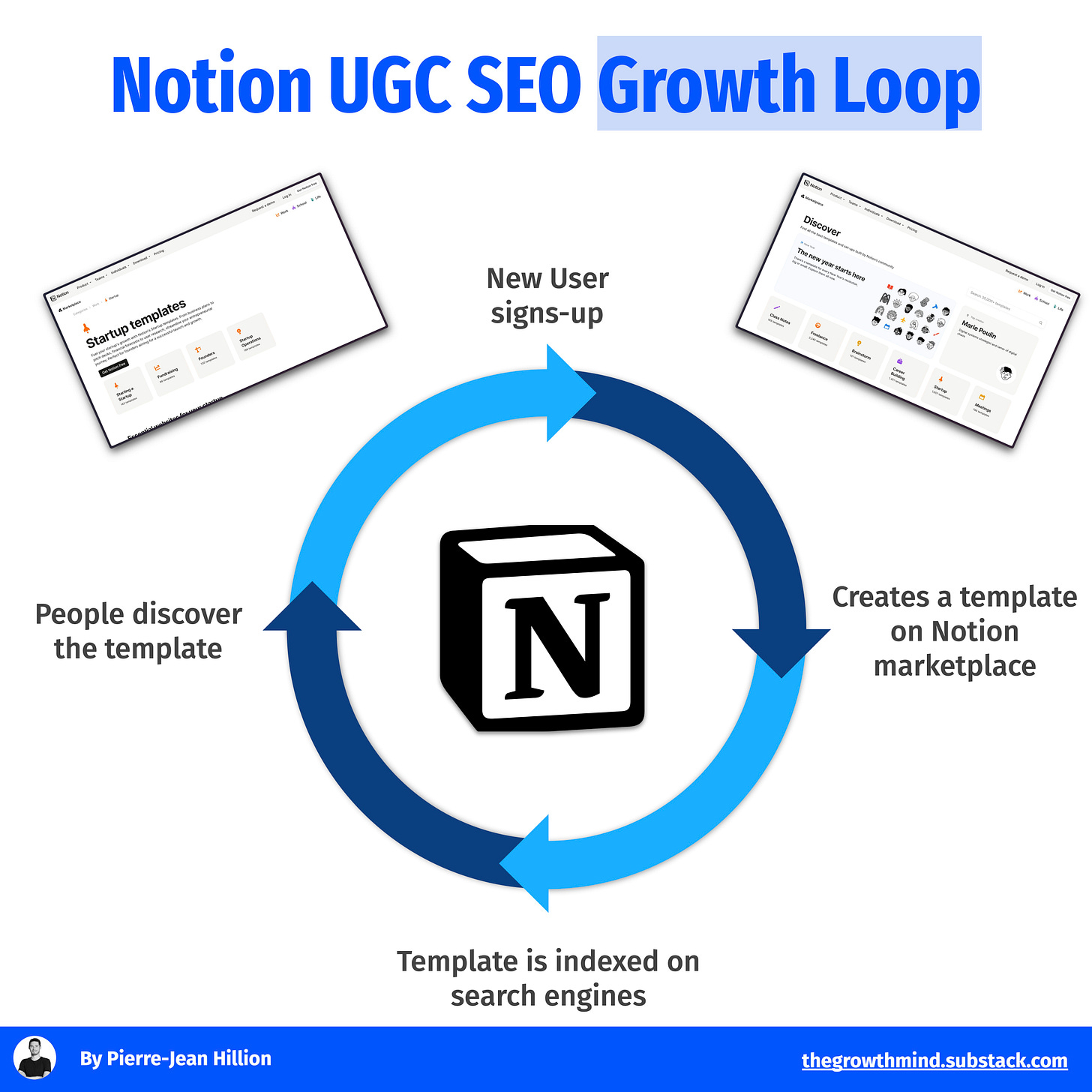Hey, Pierre-Jean here 👋 Welcome to this new edition of The Growth Mind! Each week, I share deep-dive Growth strategies, playbooks, and case studies from the best scale-ups.
For more: Best of The Growth Mind | Work with me
Today, we deep dive into a new way of doing SEO: UGC-driven assets.
Instead of relying on classic blog posts that AI can replicate in a few minutes and Google started to sanction, the smartest companies (Notion, Figma, Webflow, Framer, and more), are now turning their users into content creators to fuel SEO growth at scale.
In this playbook, we’ll break down:
Why classic top-funnel SEO is declining (and what to do instead)
How UGC-driven assets create an SEO growth loop
The examples of Notion templates & Figma Community, and actionable steps to implement this strategy
Let’s dive in!
1. SEO is changing. Top-funnel, generic blog posts are not enough anymore.
Most of you probably heard about the recent Hubspot SEO crash: they lost roughly 80% of their blog traffic in 18 months.
It created a panic wave over the marketing world, with countless theories on why it happened.
Well, the goal of this post is not to deep dive into the Hubspot case. But to get the following useful insights of it:
HubSpot’s biggest traffic drop came from top-funnel, generic keywords. Queries that weren’t necessarily driving revenue, but a lot of traffic.
AI is changing search behavior. More users now turn to AI tools (ChatGPT, Gemini, Claude…) for quick answers instead of clicking blog posts. Meanwhile, Google’s own AI-generated snippets are reducing click-through rates.
Consequently, doing SEO simply by regularly writing top-funnel, informational blog articles seems to be an outdated and inefficient tactic.
So, is SEO dead? Definitely not. SEO is still, and likely will continue to be, one of the best organic growth levers:
Traffic is evergreen: Unlike social media posts that disappear in days, SEO content drives visibility for years.
SEO tends to compound over time: The better and more content you produce, the more authority your domain gets, and the better you start ranking on the keywords you target.
It’s organic: Unlike paid ads, where you constantly need to spend to get conversions, SEO delivers constant and exponential returns over time.
The traditional SEO playbook needs to evolve. Mass-producing generic blog posts is no longer enough.
2. Entering a new SEO playbook: UGC-Driven Assets
Over the last few years, a new model has emerged, especially within the SaaS ecosystem: scaling SEO with User-Generated Content (UGC) and interactive assets.
Instead of relying on static content, created by company employees or freelancers, this approach turns users into creators who build high-intent SEO pages at scale.
UGC-Driven assets are interactive content pieces like Templates, icons, kits, product pages, community discussions…created by your users.
Why does this model work well for SEO?
Users solve their own needs: They create pieces of content they use themselves.
The content is unique and hard to replicate: Blog posts, especially in the era of AI, can be created quicker than ever. Assets are harder to copy.
It unlocks production at scale: Your users become a workforce. It’s not anymore only your marketing team creating SEO content.
It builds engagements & backlinks: Interactive assets create discussions and are highly shared, because of their usefulness.
It creates a self-sustainable Growth loop where:
1️⃣ New users sign up
2️⃣ Some create & publish assets (templates, designs, discussions, etc.)
3️⃣ These assets get indexed on Google, ranking on long-tail keywords
4️⃣ New users discover the product through organic search
5️⃣ They sign up, explore, and create more content
→ And the loop repeats, again.
This SEO growth loop is the core of how products like Notion, Figma, Webflow, and Framer cracked organic search.
3. The examples of Notion templates & Figma
A/ Notion Templates
Notion is a perfect example of mastering the UGC-driven assets for SEO playbook. They’ve created a database of 30,000+ (!) templates that both:
Help for activating users
Rank on high-intent, long-tail keywords
The notion.so/templates subfolder drove +470k visits in November 2024:
Why this strategy has been so successful for Notion?
Breadth and depth of use cases: Notion solves multiple use cases, from being your org wiki, your second brain, a mini CRM, or a marketing content calendar. The opportunities to create qualified templates are incredibly high. Consequently, they can rank on a ton of keywords, from the most classic ones (eg. “Weekly planner template”) to the most niche ones (eg. “Growth experimentations process template”).
Blank page syndrome: Landing on a blank Notion page and building everything with your small hands can feel overwhelming. Templates are great to get people started quickly by reducing friction.
Enabling monetization for their users: Your users need a benefit to create assets. In Notion’s case, you can sell templates on their marketplace. Many solopreneurs built businesses around Notion template and documented their success. Those stories inspired new users to create.
B/ Figma Community: Libraries, icons, templates & more
Figma has created a community library, featuring design templates, plugins, UI kits, icons, and more. This community library is made of tens of thousands of assets.
As you can see, some of their community pages rank at the top spots on Google:
The figma.com/community subfolder drove +1M visits in January 2025:
Why this strategy has been so successful for Figma?
Diversity of assets and use cases: As for Notion, the design use cases you can make with Figma are vast. In addition to that, designers need different types of assets for each project. This makes the playground for creating assets infinite.
Speed up the design process: Starting with a UI kit or a set of icons saves precious time for designers, then those assets have a strong value and are highly searched.
Strong social proof: Figma showcases the number of users who used one asset. Some of them have been used by millions or hundreds of thousands of users, which then creates strong credibility both for Figma and the assets shared on their community library.
As you can see, some of their community pages rank at the top spots on Google:
4. How to implement this SEO strategy for your company
So how do you replicate this strategy?
A/ Choose the right SEO asset format for your product and audience
Don’t go for templates because Notion did it. You need to choose a format that makes sense both for your product and your audience.
Aim for creating assets that:
Have a strong SEO potential.
Help users activate.
Can be produced at scale by your users.
B/ Identify strategic SEO opportunities
Use Ahrefs or Semrush to build a list of keywords you want to rank on.
Prioritize based on keywords volume, difficulty, and intention (commercial, informational, etc.)
Estimate the position you can target on those keywords, apply a CTR % based on the position, and boom, you have a rough traffic estimation. Apply a conversion rate on SEO pages, and you have an order of magnitude of the signups you could generate.
C/ Kickstart the process by building assets yourself, by creating a production and publication process
Before going all-in for UGC, start by creating and indexing assets yourself, to validate the potential and furnish your library. It will be a lot easier for your users to project themselves publishing assets on a library that is already furnished.
Define who’s producing: First, you need to choose if you want to produce in-house or delegate to a freelancer or agency. It all depends if you have the resources and competencies in-house.
Build a systemized production process: Think of the assets production as a small factory. Set a production timeline, and number of assets expected by production batch, and carefully monitor the output quality.
Index assets on your website: Create a library of assets on your website where you can easily index all your assets. As an example, here’s the Templates Library I created at Rayon, where plan templates are classified by categories and a search bar helps to browse.
Evaluate if AI can speed up the process: AI can definitely be a strong help, both for creating and publishing assets. At Rayon, I’ve built with the help of an engineer a script generating content automatically for each template page, speeding up the publication process. Some content QA is always necessary, but you’ll gain an enormous amount of time.
D/ Enable UGC to power SEO growth
Create mechanisms for users to contribute once you’ve cracked the use case yourself. If your assets have a strong monetization potential (eg. website templates), think about a marketplace where users can monetize and get reviews. They need to have a clear benefit to contribute.
Optimize content for Google indexing: structured data, metadata. Take into account that, if your users contribute, they’ll not necessarily think about SEO optimization as you’ll do. So the technical part of SEO should be perfect.
This strategy is different than the traditional SEO playbook, and certainly harder to develop. But that’s exactly why it’s a good growth strategy. It creates organic, sustainable, and defensible Growth. If you have other examples of companies that developed their SEO strategy around assets, share them in the comments!
See you next Thursday 👋
Want to work together? Here are 3 ways I can help you:
Fractional growth lead: I act as your part-time growth lead to design and execute scalable full-funnel strategies. Perfect for startups needing senior-level expertise without committing to a full-time hire.
Growth workshop: A 3-hour workshop to co-create your growth roadmap, align product & marketing teams, and set up a culture of experimentation. Perfect for a deep review of your growth engine.
Growth power hour: In-depth, 1-hour sessions to diagnose your growth challenges and provide actionable recommendations across acquisition, activation, retention, and monetization.










Being generic not only in SEO, but in all marketing aspects hurts.
I always love the saying
"Personalization sparks Attention".
Good read! Fully agree … the time of generic top of the funnel content is over (thank god).